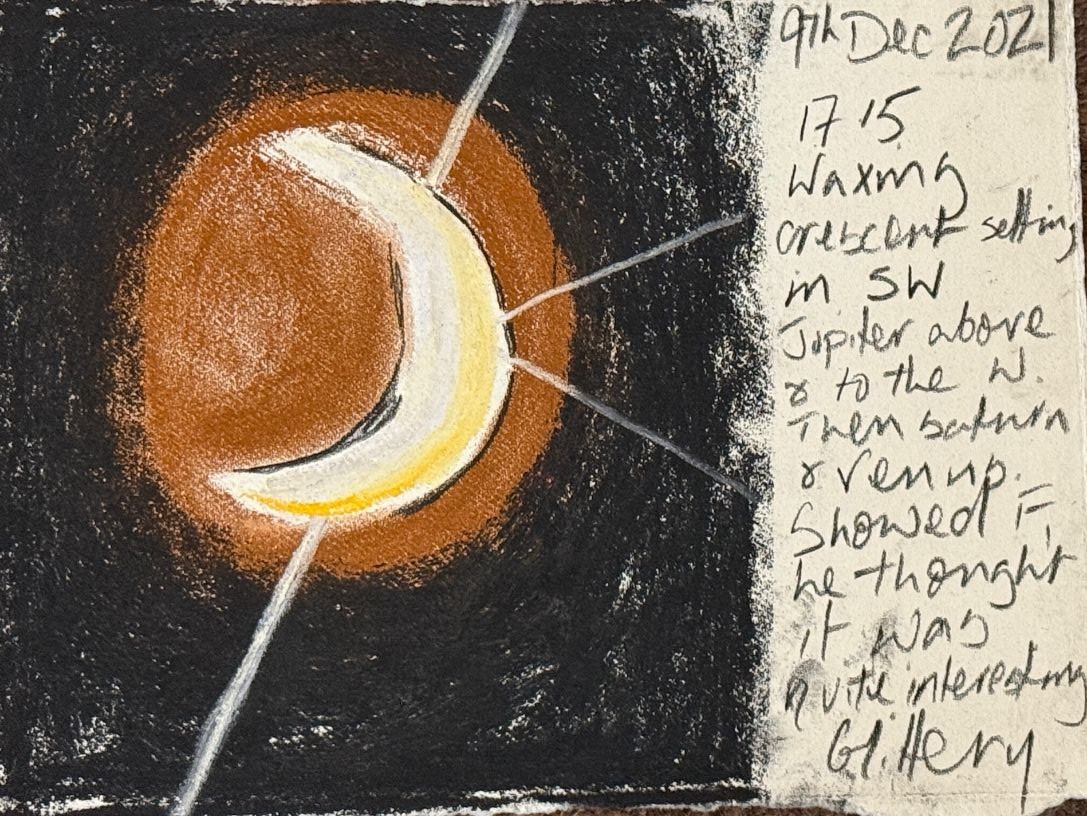The British artist Tor Falcon has given us a unique diary of her encounters with the Moon, one that will forever change your perception of that globe in the sky.
Even though the focus of the book is her artistic struggle to capture the Moon in its ever-changing appearances, her prose proves to be insightful at a deeper level. Here is a particularly revelatory and questioning passage from 31 May 2021 that does not even rely on the Moon for inspiration.
“The moon hasn’t risen yet, it’s a clear warm night. Instead of going to bed I can’t resist going outside. I’m not going to draw: I just want my fix of wandering about, looking at this place in the dark. I think of nighttime vision as a superpower now. Why was I so obsessed with lighting the dark – with trying to ‘see’ in the dark? Why did I have such a narrow sense of seeing? I CAN see in the dark, and what I see is not the daytime world I mostly live in but a parallel one that’s equally compelling. A modicum of patience is required to get there, but the reward is a slow unfolding of a place rich in subtlety and shadow where colours take on new meaning. It’s a place given to sudden, astounding bursts of brilliance and wonder. My eyes can take me to this new world without leaving home.”
Just a few days later, on 2 June, Falcon’s diary entry is a prime example of how the natural world coalesces around her view of the Moon. “Last quarter moon at its midpoint in the S. A warbler sings its heart out in a young oak growing out of brambles. Strong song, strong growth, strong yellow green, pale sky with a paler moon above a horizontal diffuse vapour trail. There’s a long comma of a cloud below the vapour trail and a thick squiggle above the moon. Like hieroglyphs. An unreadable code in the sky. Or maybe not unreadable – it says warm settled weather and a last quarter moon, all is well – and the warbler says ‘IT’S JUNE.’”
Astronomers rarely get to write such prose because few can; being trained in physics and mathematics allows no room for such holistic thoughts in a scientific paper. Most astronomers who study the sky are certainly inspired by it, but very few express their views in prose, much less art. Falcon does both, with a rare sensitivity.
For 2 years, from January 2020 to January 2022, Falcon let her artistic eye capture the moon in all its phases and moods. The book is interspersed with art: some pastel drawings were made on the spot, others were created later in her studio.
The sense of wonder is evident throughout this delightful book. At the beginning of her journey, here is Falcon on 12 Jan 2020 as she senses a glow on the horizon. “Is that the glow from Norwich? No, it’s becoming more and more intense. Real suspense as it heightens. It’s almost unbearable to watch. Finally, I can see the top edge of the moon and it’s on fire. Wow. Luminous red gold beauty with a crisp edge. In a world that has gone fuzzy with darkness, that clean curved edge of molten colour is thrilling.” Falcon often went to Cumbria, in NW England, to observe near a 1700-foot-high hill call Mellbreak. Even though it sometimes blocks the rising Moon, Falcon still senses its presence in another way. “Mellbreak is the perfect representation of the Greek myth of Endymion, the beautiful youth who lies in a perpetual sleep in a cave on Mount Latmus, and who Selene, the moon goddess, loves and visits every night.”
For those who have seen the full moon rise, have you ever thought about it like this?: “Each one different, each one extraordinary. Each one inducing a mild case of ecstasy.” These primal thoughts are of the sort that inspired people to begin building Stonehenge thousands of years ago, only 200 miles west of where Falcon lives and observes. Stonehenge was originally built as a lunar observatory, and it is this symbiotic relationship between the moon and landscape that is in the very DNA of the peoples who have inhabited the British Isles from then to the present. Luckily, in Tor Falcon, we have a brilliant exponent who can give us all the sense of lunar empowerment that – far from being lost – is still within all of us who derive from this ‘sceptered isle.’
A truly fantastic book, I recommend it most highly.
Photo: a pastel of the crescent moon on 9 Dec 2021, in my collection.
The book is available for 20 pounds at this link:
https://www.torfalcon.co.uk/bookshop/p/sugar-beet-moon-paperback-book
